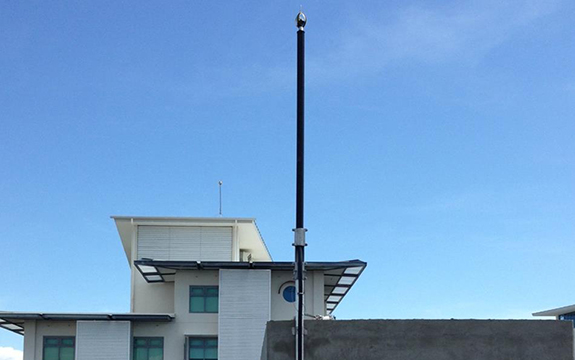
One of LPI's international air terminal installations (two terminals can be seen), protecting a hospital in India.
A new partnership between Swinburne and Lightning Protection International (LPI) will develop novel materials for LPI's lightning protection devices, known as air terminals.
The industry-led research project has been awarded $154,000 by the Australian Government through the Innovative Manufacturing Cooperative Research Centre (IMCRC), matching LPI's research and development investment making a total of $308,000.
The project will be led by Swinburne's Dr Andrew Ang and Dr Rosalie Hocking, and LPI's Dr Franco D'Alessandro.
It will enable the launch of next-generation air terminals that focus on corona minimisation. During a thunderstorm, all objects – especially sharp ones – can produce a charge in the air around their extremities that can be counterproductive for air terminals whose job it is to capture the lightning strike. This principle is now supported by a wide range of international research findings.
Air terminals intercept lightning strikes and safely pass their extremely high currents to ground through connected 'downconductors', thus protecting structures.
"One of the challenges with air terminals is that water droplets and air pollution deposits can impact their performance," says project co-lead Dr Rosalie Hocking.
"The novel materials we are developing will overcome this issue," adds Dr Franco D'Alessandro, Chief Technology Officer of LPI.
The project aims to benefit manufacturing and other industry sectors, both in Australia and internationally. It will focus on five key areas:
- Preparation of novel materials for dealing with water droplets and pollutant degradation
- Build on the expertise and critical mass of the ARC Training Centre SEAM led by Professors Christopher Berndt and Peter Kingshott. This makes the project part of Australia's premier manufacturing research and development centre, focussing on delivering outcomes for Australian manufacturers.
- Material characterisation and screening
- Prototype production and field testing
- Product evaluation and commercial recommendations
David Chuter, Managing Director and CEO of IMCRC, points out the value of collaborative research and development.
"This research collaboration is a great example of a manufacturing SME being ambitious and strategically entering a partnership with an Australian university to solve real-world problems and develop tangible and exportable technology. We are delighted to see Tasmania's LPI work with Victoria's Swinburne University," Mr Chuter says.






